REGINA SILVEIRA'S DESTRUCTION OF POWER
Barcelona's Center of Image La Virreina (La Virreina Centre de la Imatge) is dedicating an extensive exhibition to Regina Silveira (Porto Alegre, Brazil, 1939), one of the multimedia artists and key figures of Latin American conceptual art. Within the exhibition line of the center, which advocates the exploration of the aesthetic and ideological languages of images, this show curated by Isabella Lenzi covers a wide range of the Brazilian artist's research, experimentation and artistic production, particularly that developed with technical reproduction techniques and the circulation of images.
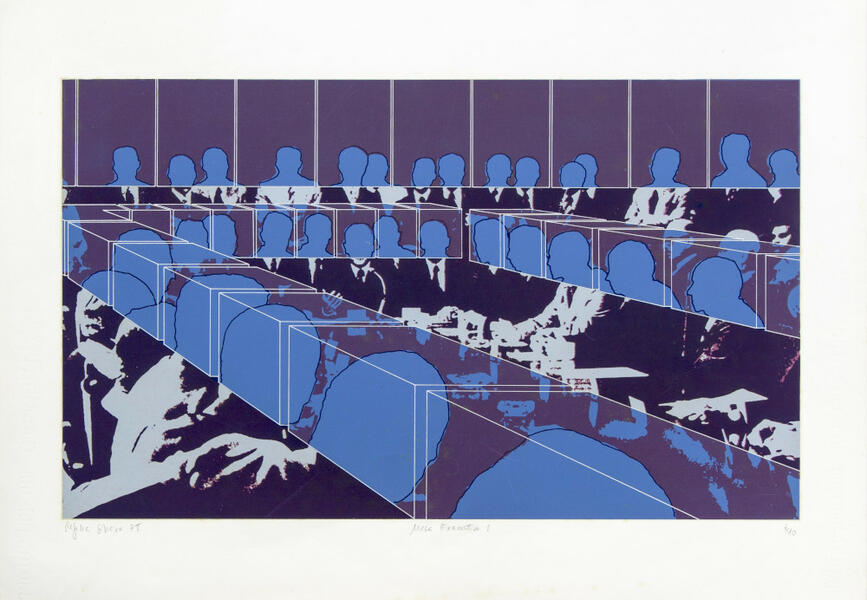
In this constant research that she has been conducting for more than six decades, Silveira has sought to find, through analysis and criticism, central elements that can deconstruct conventional representational systems. For all these reasons, the questioning of the possibilities of perspective and visual perception, irony as an instrument and the rethinking of concepts have always been present in his projects.
Destructuras de poder focuses especially on his production made during the Brazilian authoritarian period between 1964 and 1985, a proposal mediated by the repressive environment of censorship and violence. Perhaps this is a little known part of the artist, but it is fundamental to understand the functioning of alternative systems of artistic exchange networks and mail art outside the industry and the market.
Observing from the media, which she also uses for her idea of diffusion, Silveira analyzes institutional power and its symbolism, later evolving towards a more social focus and even towards a primitive decolonization of the clichés associated with her country and Latin America.
This exhibition includes, in addition to his most recognizable works, elements such as sketches and models of large-scale architectural and urban interventions and an augmented reality piece located in the courtyard of the Palau de la Virreina.
-
Regina Silveira_Destructuras de poder_Braziltoday
-
Regina Silveira_Destructuras de poder_Braziltoday
-
Regina Silveira_Destructuras de poder_Mesa executiva 1
-
Regina Silveira_Destructuras de poder_PudimArteBrasilera
-
Regina Silveira_Destructuras de poder_São Paulo turístico
-
Regina Silveira_Destructuras de poder_The Saint’s Paradox
-
Regina Silveira_Destructuras de poder_To Be Continued(Latin American Puzzle)
Destructions of Power. Regina Silveira can be seen until March 30, 2025 at Center of Image La Virreina (La Virreina Centre de la Imatge), La Rambla, 99, Barcelona (Spain).
May interest you
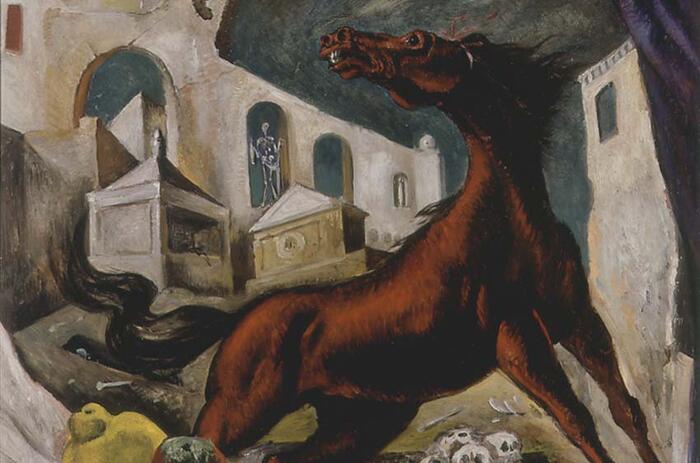
Fundación Casa de Mexico in Spain hosts the exhibition Modern Art of Mexico, with funds from the Blaisten Collection and curated by Daniel Garza Usabiaga, which takes an interesting look at the country's 20th century production through the eyes of Margarita Nelken (Madrid, Spain, 1894-Mexico City, Mexico, 1968).
MEXICAN MODERN ART ACCORDING TO NELKEN AND THE BLAISTEN COLLECTION
Fundación Casa de Mexico in Spain hosts the exhibition Modern Art of Mexico, with funds from the Blaisten Collection and curated by Daniel Garza Usabiaga, which takes an interesting look at the country's 20th century production through the eyes of Margarita Nelken (Madrid, Spain, 1894-Mexico City, Mexico, 1968).

Fundación Casa de Mexico in Spain hosts the exhibition Modern Art of Mexico, with funds from the Blaisten Collection and curated by Daniel Garza Usabiaga, which takes an interesting look at the country's 20th century production through the eyes of Margarita Nelken (Madrid, Spain, 1894-Mexico City, Mexico, 1968).
MEXICAN MODERN ART ACCORDING TO NELKEN AND THE BLAISTEN COLLECTION
Fundación Casa de Mexico in Spain hosts the exhibition Modern Art of Mexico, with funds from the Blaisten Collection and curated by Daniel Garza Usabiaga, which takes an interesting look at the country's 20th century production through the eyes of Margarita Nelken (Madrid, Spain, 1894-Mexico City, Mexico, 1968).
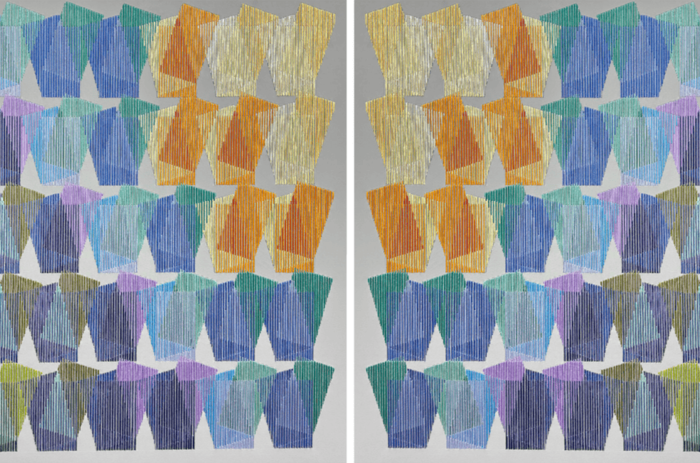
Isabella Despujols (Barquisemeto, Venezuela, 1994), Venezuelan artist based in Brazil, uses her artistic references for the realization of her latest series of works, a set made this year where textiles and embroidery are especially relevant, as well as the formal fact that they reflect. In them is palpable the conversation that he intends to maintain with those styles and languages that were fundamental in the countries to which he circumscribes his personal experience.
DESPUJOLS' EMBROIDERED GEOMETRY AT LLAMAZARES
Isabella Despujols (Barquisemeto, Venezuela, 1994), Venezuelan artist based in Brazil, uses her artistic references for the realization of her latest series of works, a set made this year where textiles and embroidery are especially relevant, as well as the formal fact that they reflect. In them is palpable the conversation that he intends to maintain with those styles and languages that were fundamental in the countries to which he circumscribes his personal experience.

Based on the biologicist theories on territoriality and the relationships derived from living beings with their immediate environment, the Angeles Baños gallery from Badajoz proposes an exhibition project to three Latin American artists so that, through their experiences and their personal vision, they can materialize and express those feelings of territoriality, and always from the parallelism of the human being with the rest of living beings.
THE TERRITORIAL BY THREE LATIN AMERICAN ARTISTS AT ÁNGELES BAÑOS
Based on the biologicist theories on territoriality and the relationships derived from living beings with their immediate environment, the Angeles Baños gallery from Badajoz proposes an exhibition project to three Latin American artists so that, through their experiences and their personal vision, they can materialize and express those feelings of territoriality, and always from the parallelism of the human being with the rest of living beings.
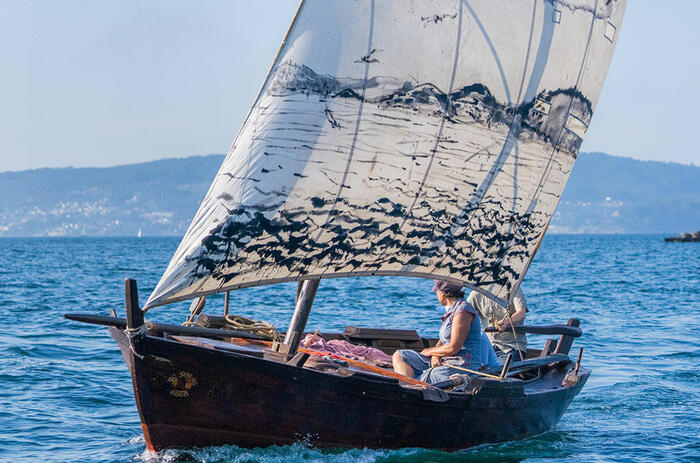
The Museum of Pontevedra exhibits Vento (wind, in Galician), the proposal that the artist Alberto Baraya (Bogota, Colombia, 1968) has developed and now shows at its headquarters in the Castelao Building as part of the cycle of exhibitions Infiltracións. This program aims to carry out specific projects that have as their backbone the dialogue arising from research and work with pieces from the collection of the Galician institution to promote re-readings on it.
VENTO BY ALBERTO BARAYA – IN PONTEVEDRA
The Museum of Pontevedra exhibits Vento (wind, in Galician), the proposal that the artist Alberto Baraya (Bogota, Colombia, 1968) has developed and now shows at its headquarters in the Castelao Building as part of the cycle of exhibitions Infiltracións. This program aims to carry out specific projects that have as their backbone the dialogue arising from research and work with pieces from the collection of the Galician institution to promote re-readings on it.
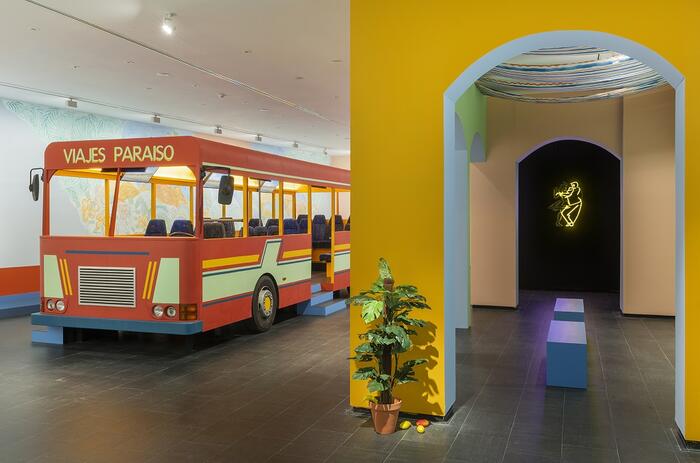
Sol Calero (Caracas, Venezuela, 1982) uses the guanabana, a fruit endemic to Central America and the Caribbean, to symbolically instrumentalize the creation of a representation of the feelings of belonging, home, everyday life and stereotypes through the wide conquest of the spaces of the Museo Centro de Arte Dos de Mayo, transformed for the occasion into visual and popular references of a well-known and recognized Latin America.
IDENTITY AND HOME – ACCORDING TO SOL CALERO IN THE CA2M MUSEUM
Sol Calero (Caracas, Venezuela, 1982) uses the guanabana, a fruit endemic to Central America and the Caribbean, to symbolically instrumentalize the creation of a representation of the feelings of belonging, home, everyday life and stereotypes through the wide conquest of the spaces of the Museo Centro de Arte Dos de Mayo, transformed for the occasion into visual and popular references of a well-known and recognized Latin America.
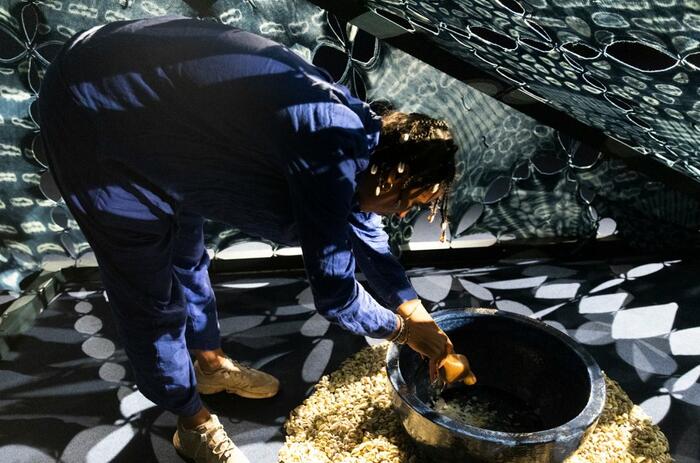
Nebulosa de la calabaza is the title of the first solo exhibition presented in Spain by Tabita Rezaire (Paris, France, 1989), an artist living in French Guiana. Renowned for her use of new media and multidisciplinarity to explore the relationship between contemporary worlds transited from technology and their relationship with the most ancestral and spiritual environment, the Guyanese-heritage artist focuses her production on activism from the perspective of denunciation from feminism and decolonization as key points.
DENOUNCEMENT AND ORIGIN IN TABITA REZAIRE
Nebulosa de la calabaza is the title of the first solo exhibition presented in Spain by Tabita Rezaire (Paris, France, 1989), an artist living in French Guiana. Renowned for her use of new media and multidisciplinarity to explore the relationship between contemporary worlds transited from technology and their relationship with the most ancestral and spiritual environment, the Guyanese-heritage artist focuses her production on activism from the perspective of denunciation from feminism and decolonization as key points.
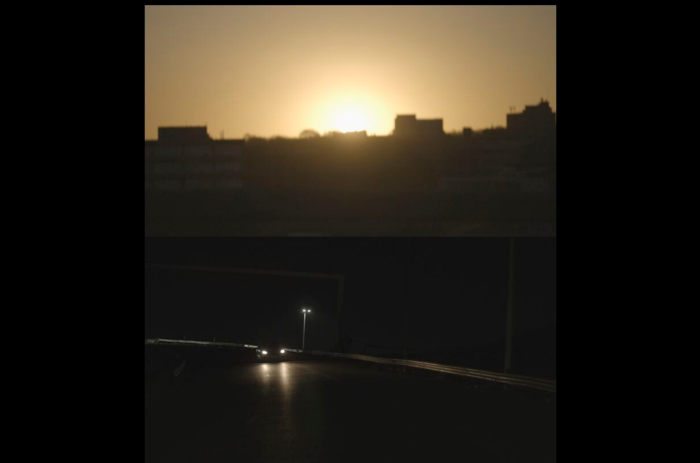
Dim Corners is an evocative exhibition in Johannesburg featuring new works by Brazilian artist Leticia Ramos and South African artist Zen Marie. The exhibition takes into account the city’s frequent energy shortages, and also the recent blackouts that São Paulo had experienced since this project started, weaving a narrative that intertwines the immediate physical impact with the broader, insidious issues of climate change and environmental racism.
LETICIA RAMOS & ZEN MARIE IN A COLLABORATIVE PROJECT
Dim Corners is an evocative exhibition in Johannesburg featuring new works by Brazilian artist Leticia Ramos and South African artist Zen Marie. The exhibition takes into account the city’s frequent energy shortages, and also the recent blackouts that São Paulo had experienced since this project started, weaving a narrative that intertwines the immediate physical impact with the broader, insidious issues of climate change and environmental racism.

The São Paulo Museum of Art (MASP) presents the exhibition Serigrafistas Queer: Liberdade para as sensibilidades (Freedom for sensibilities) from December 13 to March 16, 2025. It addresses themes such as the struggle for reproductive rights, bodily autonomy, the political approach to the HIV crisis, and the celebration of diverse affections and identities.
ARGENTINE QUEER COLLECTIVE AT MASP: ACTIVISM, REPRODUCTIVE RIGHTS AND DIVERSE IDENTITIES
The São Paulo Museum of Art (MASP) presents the exhibition Serigrafistas Queer: Liberdade para as sensibilidades (Freedom for sensibilities) from December 13 to March 16, 2025. It addresses themes such as the struggle for reproductive rights, bodily autonomy, the political approach to the HIV crisis, and the celebration of diverse affections and identities.

Fundación Casa de Mexico in Spain hosts the exhibition Modern Art of Mexico, with funds from the Blaisten Collection and curated by Daniel Garza Usabiaga, which takes an interesting look at the country's 20th century production through the eyes of Margarita Nelken (Madrid, Spain, 1894-Mexico City, Mexico, 1968).
MEXICAN MODERN ART ACCORDING TO NELKEN AND THE BLAISTEN COLLECTION
Fundación Casa de Mexico in Spain hosts the exhibition Modern Art of Mexico, with funds from the Blaisten Collection and curated by Daniel Garza Usabiaga, which takes an interesting look at the country's 20th century production through the eyes of Margarita Nelken (Madrid, Spain, 1894-Mexico City, Mexico, 1968).

Isabella Despujols (Barquisemeto, Venezuela, 1994), Venezuelan artist based in Brazil, uses her artistic references for the realization of her latest series of works, a set made this year where textiles and embroidery are especially relevant, as well as the formal fact that they reflect. In them is palpable the conversation that he intends to maintain with those styles and languages that were fundamental in the countries to which he circumscribes his personal experience.
DESPUJOLS' EMBROIDERED GEOMETRY AT LLAMAZARES
Isabella Despujols (Barquisemeto, Venezuela, 1994), Venezuelan artist based in Brazil, uses her artistic references for the realization of her latest series of works, a set made this year where textiles and embroidery are especially relevant, as well as the formal fact that they reflect. In them is palpable the conversation that he intends to maintain with those styles and languages that were fundamental in the countries to which he circumscribes his personal experience.

Based on the biologicist theories on territoriality and the relationships derived from living beings with their immediate environment, the Angeles Baños gallery from Badajoz proposes an exhibition project to three Latin American artists so that, through their experiences and their personal vision, they can materialize and express those feelings of territoriality, and always from the parallelism of the human being with the rest of living beings.
THE TERRITORIAL BY THREE LATIN AMERICAN ARTISTS AT ÁNGELES BAÑOS
Based on the biologicist theories on territoriality and the relationships derived from living beings with their immediate environment, the Angeles Baños gallery from Badajoz proposes an exhibition project to three Latin American artists so that, through their experiences and their personal vision, they can materialize and express those feelings of territoriality, and always from the parallelism of the human being with the rest of living beings.

The Museum of Pontevedra exhibits Vento (wind, in Galician), the proposal that the artist Alberto Baraya (Bogota, Colombia, 1968) has developed and now shows at its headquarters in the Castelao Building as part of the cycle of exhibitions Infiltracións. This program aims to carry out specific projects that have as their backbone the dialogue arising from research and work with pieces from the collection of the Galician institution to promote re-readings on it.
VENTO BY ALBERTO BARAYA – IN PONTEVEDRA
The Museum of Pontevedra exhibits Vento (wind, in Galician), the proposal that the artist Alberto Baraya (Bogota, Colombia, 1968) has developed and now shows at its headquarters in the Castelao Building as part of the cycle of exhibitions Infiltracións. This program aims to carry out specific projects that have as their backbone the dialogue arising from research and work with pieces from the collection of the Galician institution to promote re-readings on it.

Sol Calero (Caracas, Venezuela, 1982) uses the guanabana, a fruit endemic to Central America and the Caribbean, to symbolically instrumentalize the creation of a representation of the feelings of belonging, home, everyday life and stereotypes through the wide conquest of the spaces of the Museo Centro de Arte Dos de Mayo, transformed for the occasion into visual and popular references of a well-known and recognized Latin America.
IDENTITY AND HOME – ACCORDING TO SOL CALERO IN THE CA2M MUSEUM
Sol Calero (Caracas, Venezuela, 1982) uses the guanabana, a fruit endemic to Central America and the Caribbean, to symbolically instrumentalize the creation of a representation of the feelings of belonging, home, everyday life and stereotypes through the wide conquest of the spaces of the Museo Centro de Arte Dos de Mayo, transformed for the occasion into visual and popular references of a well-known and recognized Latin America.

Nebulosa de la calabaza is the title of the first solo exhibition presented in Spain by Tabita Rezaire (Paris, France, 1989), an artist living in French Guiana. Renowned for her use of new media and multidisciplinarity to explore the relationship between contemporary worlds transited from technology and their relationship with the most ancestral and spiritual environment, the Guyanese-heritage artist focuses her production on activism from the perspective of denunciation from feminism and decolonization as key points.
DENOUNCEMENT AND ORIGIN IN TABITA REZAIRE
Nebulosa de la calabaza is the title of the first solo exhibition presented in Spain by Tabita Rezaire (Paris, France, 1989), an artist living in French Guiana. Renowned for her use of new media and multidisciplinarity to explore the relationship between contemporary worlds transited from technology and their relationship with the most ancestral and spiritual environment, the Guyanese-heritage artist focuses her production on activism from the perspective of denunciation from feminism and decolonization as key points.

Dim Corners is an evocative exhibition in Johannesburg featuring new works by Brazilian artist Leticia Ramos and South African artist Zen Marie. The exhibition takes into account the city’s frequent energy shortages, and also the recent blackouts that São Paulo had experienced since this project started, weaving a narrative that intertwines the immediate physical impact with the broader, insidious issues of climate change and environmental racism.
LETICIA RAMOS & ZEN MARIE IN A COLLABORATIVE PROJECT
Dim Corners is an evocative exhibition in Johannesburg featuring new works by Brazilian artist Leticia Ramos and South African artist Zen Marie. The exhibition takes into account the city’s frequent energy shortages, and also the recent blackouts that São Paulo had experienced since this project started, weaving a narrative that intertwines the immediate physical impact with the broader, insidious issues of climate change and environmental racism.

The São Paulo Museum of Art (MASP) presents the exhibition Serigrafistas Queer: Liberdade para as sensibilidades (Freedom for sensibilities) from December 13 to March 16, 2025. It addresses themes such as the struggle for reproductive rights, bodily autonomy, the political approach to the HIV crisis, and the celebration of diverse affections and identities.
ARGENTINE QUEER COLLECTIVE AT MASP: ACTIVISM, REPRODUCTIVE RIGHTS AND DIVERSE IDENTITIES
The São Paulo Museum of Art (MASP) presents the exhibition Serigrafistas Queer: Liberdade para as sensibilidades (Freedom for sensibilities) from December 13 to March 16, 2025. It addresses themes such as the struggle for reproductive rights, bodily autonomy, the political approach to the HIV crisis, and the celebration of diverse affections and identities.

Fundación Casa de Mexico in Spain hosts the exhibition Modern Art of Mexico, with funds from the Blaisten Collection and curated by Daniel Garza Usabiaga, which takes an interesting look at the country's 20th century production through the eyes of Margarita Nelken (Madrid, Spain, 1894-Mexico City, Mexico, 1968).
MEXICAN MODERN ART ACCORDING TO NELKEN AND THE BLAISTEN COLLECTION
Fundación Casa de Mexico in Spain hosts the exhibition Modern Art of Mexico, with funds from the Blaisten Collection and curated by Daniel Garza Usabiaga, which takes an interesting look at the country's 20th century production through the eyes of Margarita Nelken (Madrid, Spain, 1894-Mexico City, Mexico, 1968).

Isabella Despujols (Barquisemeto, Venezuela, 1994), Venezuelan artist based in Brazil, uses her artistic references for the realization of her latest series of works, a set made this year where textiles and embroidery are especially relevant, as well as the formal fact that they reflect. In them is palpable the conversation that he intends to maintain with those styles and languages that were fundamental in the countries to which he circumscribes his personal experience.
DESPUJOLS' EMBROIDERED GEOMETRY AT LLAMAZARES
Isabella Despujols (Barquisemeto, Venezuela, 1994), Venezuelan artist based in Brazil, uses her artistic references for the realization of her latest series of works, a set made this year where textiles and embroidery are especially relevant, as well as the formal fact that they reflect. In them is palpable the conversation that he intends to maintain with those styles and languages that were fundamental in the countries to which he circumscribes his personal experience.

Based on the biologicist theories on territoriality and the relationships derived from living beings with their immediate environment, the Angeles Baños gallery from Badajoz proposes an exhibition project to three Latin American artists so that, through their experiences and their personal vision, they can materialize and express those feelings of territoriality, and always from the parallelism of the human being with the rest of living beings.
THE TERRITORIAL BY THREE LATIN AMERICAN ARTISTS AT ÁNGELES BAÑOS
Based on the biologicist theories on territoriality and the relationships derived from living beings with their immediate environment, the Angeles Baños gallery from Badajoz proposes an exhibition project to three Latin American artists so that, through their experiences and their personal vision, they can materialize and express those feelings of territoriality, and always from the parallelism of the human being with the rest of living beings.

The Museum of Pontevedra exhibits Vento (wind, in Galician), the proposal that the artist Alberto Baraya (Bogota, Colombia, 1968) has developed and now shows at its headquarters in the Castelao Building as part of the cycle of exhibitions Infiltracións. This program aims to carry out specific projects that have as their backbone the dialogue arising from research and work with pieces from the collection of the Galician institution to promote re-readings on it.
VENTO BY ALBERTO BARAYA – IN PONTEVEDRA
The Museum of Pontevedra exhibits Vento (wind, in Galician), the proposal that the artist Alberto Baraya (Bogota, Colombia, 1968) has developed and now shows at its headquarters in the Castelao Building as part of the cycle of exhibitions Infiltracións. This program aims to carry out specific projects that have as their backbone the dialogue arising from research and work with pieces from the collection of the Galician institution to promote re-readings on it.

Sol Calero (Caracas, Venezuela, 1982) uses the guanabana, a fruit endemic to Central America and the Caribbean, to symbolically instrumentalize the creation of a representation of the feelings of belonging, home, everyday life and stereotypes through the wide conquest of the spaces of the Museo Centro de Arte Dos de Mayo, transformed for the occasion into visual and popular references of a well-known and recognized Latin America.
IDENTITY AND HOME – ACCORDING TO SOL CALERO IN THE CA2M MUSEUM
Sol Calero (Caracas, Venezuela, 1982) uses the guanabana, a fruit endemic to Central America and the Caribbean, to symbolically instrumentalize the creation of a representation of the feelings of belonging, home, everyday life and stereotypes through the wide conquest of the spaces of the Museo Centro de Arte Dos de Mayo, transformed for the occasion into visual and popular references of a well-known and recognized Latin America.

Nebulosa de la calabaza is the title of the first solo exhibition presented in Spain by Tabita Rezaire (Paris, France, 1989), an artist living in French Guiana. Renowned for her use of new media and multidisciplinarity to explore the relationship between contemporary worlds transited from technology and their relationship with the most ancestral and spiritual environment, the Guyanese-heritage artist focuses her production on activism from the perspective of denunciation from feminism and decolonization as key points.
DENOUNCEMENT AND ORIGIN IN TABITA REZAIRE
Nebulosa de la calabaza is the title of the first solo exhibition presented in Spain by Tabita Rezaire (Paris, France, 1989), an artist living in French Guiana. Renowned for her use of new media and multidisciplinarity to explore the relationship between contemporary worlds transited from technology and their relationship with the most ancestral and spiritual environment, the Guyanese-heritage artist focuses her production on activism from the perspective of denunciation from feminism and decolonization as key points.

Dim Corners is an evocative exhibition in Johannesburg featuring new works by Brazilian artist Leticia Ramos and South African artist Zen Marie. The exhibition takes into account the city’s frequent energy shortages, and also the recent blackouts that São Paulo had experienced since this project started, weaving a narrative that intertwines the immediate physical impact with the broader, insidious issues of climate change and environmental racism.
LETICIA RAMOS & ZEN MARIE IN A COLLABORATIVE PROJECT
Dim Corners is an evocative exhibition in Johannesburg featuring new works by Brazilian artist Leticia Ramos and South African artist Zen Marie. The exhibition takes into account the city’s frequent energy shortages, and also the recent blackouts that São Paulo had experienced since this project started, weaving a narrative that intertwines the immediate physical impact with the broader, insidious issues of climate change and environmental racism.

The São Paulo Museum of Art (MASP) presents the exhibition Serigrafistas Queer: Liberdade para as sensibilidades (Freedom for sensibilities) from December 13 to March 16, 2025. It addresses themes such as the struggle for reproductive rights, bodily autonomy, the political approach to the HIV crisis, and the celebration of diverse affections and identities.
ARGENTINE QUEER COLLECTIVE AT MASP: ACTIVISM, REPRODUCTIVE RIGHTS AND DIVERSE IDENTITIES
The São Paulo Museum of Art (MASP) presents the exhibition Serigrafistas Queer: Liberdade para as sensibilidades (Freedom for sensibilities) from December 13 to March 16, 2025. It addresses themes such as the struggle for reproductive rights, bodily autonomy, the political approach to the HIV crisis, and the celebration of diverse affections and identities.

Fundación Casa de Mexico in Spain hosts the exhibition Modern Art of Mexico, with funds from the Blaisten Collection and curated by Daniel Garza Usabiaga, which takes an interesting look at the country's 20th century production through the eyes of Margarita Nelken (Madrid, Spain, 1894-Mexico City, Mexico, 1968).
MEXICAN MODERN ART ACCORDING TO NELKEN AND THE BLAISTEN COLLECTION
Fundación Casa de Mexico in Spain hosts the exhibition Modern Art of Mexico, with funds from the Blaisten Collection and curated by Daniel Garza Usabiaga, which takes an interesting look at the country's 20th century production through the eyes of Margarita Nelken (Madrid, Spain, 1894-Mexico City, Mexico, 1968).

Isabella Despujols (Barquisemeto, Venezuela, 1994), Venezuelan artist based in Brazil, uses her artistic references for the realization of her latest series of works, a set made this year where textiles and embroidery are especially relevant, as well as the formal fact that they reflect. In them is palpable the conversation that he intends to maintain with those styles and languages that were fundamental in the countries to which he circumscribes his personal experience.
DESPUJOLS' EMBROIDERED GEOMETRY AT LLAMAZARES
Isabella Despujols (Barquisemeto, Venezuela, 1994), Venezuelan artist based in Brazil, uses her artistic references for the realization of her latest series of works, a set made this year where textiles and embroidery are especially relevant, as well as the formal fact that they reflect. In them is palpable the conversation that he intends to maintain with those styles and languages that were fundamental in the countries to which he circumscribes his personal experience.

Based on the biologicist theories on territoriality and the relationships derived from living beings with their immediate environment, the Angeles Baños gallery from Badajoz proposes an exhibition project to three Latin American artists so that, through their experiences and their personal vision, they can materialize and express those feelings of territoriality, and always from the parallelism of the human being with the rest of living beings.
THE TERRITORIAL BY THREE LATIN AMERICAN ARTISTS AT ÁNGELES BAÑOS
Based on the biologicist theories on territoriality and the relationships derived from living beings with their immediate environment, the Angeles Baños gallery from Badajoz proposes an exhibition project to three Latin American artists so that, through their experiences and their personal vision, they can materialize and express those feelings of territoriality, and always from the parallelism of the human being with the rest of living beings.

The Museum of Pontevedra exhibits Vento (wind, in Galician), the proposal that the artist Alberto Baraya (Bogota, Colombia, 1968) has developed and now shows at its headquarters in the Castelao Building as part of the cycle of exhibitions Infiltracións. This program aims to carry out specific projects that have as their backbone the dialogue arising from research and work with pieces from the collection of the Galician institution to promote re-readings on it.
VENTO BY ALBERTO BARAYA – IN PONTEVEDRA
The Museum of Pontevedra exhibits Vento (wind, in Galician), the proposal that the artist Alberto Baraya (Bogota, Colombia, 1968) has developed and now shows at its headquarters in the Castelao Building as part of the cycle of exhibitions Infiltracións. This program aims to carry out specific projects that have as their backbone the dialogue arising from research and work with pieces from the collection of the Galician institution to promote re-readings on it.

Sol Calero (Caracas, Venezuela, 1982) uses the guanabana, a fruit endemic to Central America and the Caribbean, to symbolically instrumentalize the creation of a representation of the feelings of belonging, home, everyday life and stereotypes through the wide conquest of the spaces of the Museo Centro de Arte Dos de Mayo, transformed for the occasion into visual and popular references of a well-known and recognized Latin America.
IDENTITY AND HOME – ACCORDING TO SOL CALERO IN THE CA2M MUSEUM
Sol Calero (Caracas, Venezuela, 1982) uses the guanabana, a fruit endemic to Central America and the Caribbean, to symbolically instrumentalize the creation of a representation of the feelings of belonging, home, everyday life and stereotypes through the wide conquest of the spaces of the Museo Centro de Arte Dos de Mayo, transformed for the occasion into visual and popular references of a well-known and recognized Latin America.

Nebulosa de la calabaza is the title of the first solo exhibition presented in Spain by Tabita Rezaire (Paris, France, 1989), an artist living in French Guiana. Renowned for her use of new media and multidisciplinarity to explore the relationship between contemporary worlds transited from technology and their relationship with the most ancestral and spiritual environment, the Guyanese-heritage artist focuses her production on activism from the perspective of denunciation from feminism and decolonization as key points.
DENOUNCEMENT AND ORIGIN IN TABITA REZAIRE
Nebulosa de la calabaza is the title of the first solo exhibition presented in Spain by Tabita Rezaire (Paris, France, 1989), an artist living in French Guiana. Renowned for her use of new media and multidisciplinarity to explore the relationship between contemporary worlds transited from technology and their relationship with the most ancestral and spiritual environment, the Guyanese-heritage artist focuses her production on activism from the perspective of denunciation from feminism and decolonization as key points.

Dim Corners is an evocative exhibition in Johannesburg featuring new works by Brazilian artist Leticia Ramos and South African artist Zen Marie. The exhibition takes into account the city’s frequent energy shortages, and also the recent blackouts that São Paulo had experienced since this project started, weaving a narrative that intertwines the immediate physical impact with the broader, insidious issues of climate change and environmental racism.
LETICIA RAMOS & ZEN MARIE IN A COLLABORATIVE PROJECT
Dim Corners is an evocative exhibition in Johannesburg featuring new works by Brazilian artist Leticia Ramos and South African artist Zen Marie. The exhibition takes into account the city’s frequent energy shortages, and also the recent blackouts that São Paulo had experienced since this project started, weaving a narrative that intertwines the immediate physical impact with the broader, insidious issues of climate change and environmental racism.

The São Paulo Museum of Art (MASP) presents the exhibition Serigrafistas Queer: Liberdade para as sensibilidades (Freedom for sensibilities) from December 13 to March 16, 2025. It addresses themes such as the struggle for reproductive rights, bodily autonomy, the political approach to the HIV crisis, and the celebration of diverse affections and identities.
ARGENTINE QUEER COLLECTIVE AT MASP: ACTIVISM, REPRODUCTIVE RIGHTS AND DIVERSE IDENTITIES
The São Paulo Museum of Art (MASP) presents the exhibition Serigrafistas Queer: Liberdade para as sensibilidades (Freedom for sensibilities) from December 13 to March 16, 2025. It addresses themes such as the struggle for reproductive rights, bodily autonomy, the political approach to the HIV crisis, and the celebration of diverse affections and identities.

Fundación Casa de Mexico in Spain hosts the exhibition Modern Art of Mexico, with funds from the Blaisten Collection and curated by Daniel Garza Usabiaga, which takes an interesting look at the country's 20th century production through the eyes of Margarita Nelken (Madrid, Spain, 1894-Mexico City, Mexico, 1968).
MEXICAN MODERN ART ACCORDING TO NELKEN AND THE BLAISTEN COLLECTION
Fundación Casa de Mexico in Spain hosts the exhibition Modern Art of Mexico, with funds from the Blaisten Collection and curated by Daniel Garza Usabiaga, which takes an interesting look at the country's 20th century production through the eyes of Margarita Nelken (Madrid, Spain, 1894-Mexico City, Mexico, 1968).

Isabella Despujols (Barquisemeto, Venezuela, 1994), Venezuelan artist based in Brazil, uses her artistic references for the realization of her latest series of works, a set made this year where textiles and embroidery are especially relevant, as well as the formal fact that they reflect. In them is palpable the conversation that he intends to maintain with those styles and languages that were fundamental in the countries to which he circumscribes his personal experience.
DESPUJOLS' EMBROIDERED GEOMETRY AT LLAMAZARES
Isabella Despujols (Barquisemeto, Venezuela, 1994), Venezuelan artist based in Brazil, uses her artistic references for the realization of her latest series of works, a set made this year where textiles and embroidery are especially relevant, as well as the formal fact that they reflect. In them is palpable the conversation that he intends to maintain with those styles and languages that were fundamental in the countries to which he circumscribes his personal experience.

Based on the biologicist theories on territoriality and the relationships derived from living beings with their immediate environment, the Angeles Baños gallery from Badajoz proposes an exhibition project to three Latin American artists so that, through their experiences and their personal vision, they can materialize and express those feelings of territoriality, and always from the parallelism of the human being with the rest of living beings.
THE TERRITORIAL BY THREE LATIN AMERICAN ARTISTS AT ÁNGELES BAÑOS
Based on the biologicist theories on territoriality and the relationships derived from living beings with their immediate environment, the Angeles Baños gallery from Badajoz proposes an exhibition project to three Latin American artists so that, through their experiences and their personal vision, they can materialize and express those feelings of territoriality, and always from the parallelism of the human being with the rest of living beings.

The Museum of Pontevedra exhibits Vento (wind, in Galician), the proposal that the artist Alberto Baraya (Bogota, Colombia, 1968) has developed and now shows at its headquarters in the Castelao Building as part of the cycle of exhibitions Infiltracións. This program aims to carry out specific projects that have as their backbone the dialogue arising from research and work with pieces from the collection of the Galician institution to promote re-readings on it.
VENTO BY ALBERTO BARAYA – IN PONTEVEDRA
The Museum of Pontevedra exhibits Vento (wind, in Galician), the proposal that the artist Alberto Baraya (Bogota, Colombia, 1968) has developed and now shows at its headquarters in the Castelao Building as part of the cycle of exhibitions Infiltracións. This program aims to carry out specific projects that have as their backbone the dialogue arising from research and work with pieces from the collection of the Galician institution to promote re-readings on it.

Sol Calero (Caracas, Venezuela, 1982) uses the guanabana, a fruit endemic to Central America and the Caribbean, to symbolically instrumentalize the creation of a representation of the feelings of belonging, home, everyday life and stereotypes through the wide conquest of the spaces of the Museo Centro de Arte Dos de Mayo, transformed for the occasion into visual and popular references of a well-known and recognized Latin America.
IDENTITY AND HOME – ACCORDING TO SOL CALERO IN THE CA2M MUSEUM
Sol Calero (Caracas, Venezuela, 1982) uses the guanabana, a fruit endemic to Central America and the Caribbean, to symbolically instrumentalize the creation of a representation of the feelings of belonging, home, everyday life and stereotypes through the wide conquest of the spaces of the Museo Centro de Arte Dos de Mayo, transformed for the occasion into visual and popular references of a well-known and recognized Latin America.

Nebulosa de la calabaza is the title of the first solo exhibition presented in Spain by Tabita Rezaire (Paris, France, 1989), an artist living in French Guiana. Renowned for her use of new media and multidisciplinarity to explore the relationship between contemporary worlds transited from technology and their relationship with the most ancestral and spiritual environment, the Guyanese-heritage artist focuses her production on activism from the perspective of denunciation from feminism and decolonization as key points.
DENOUNCEMENT AND ORIGIN IN TABITA REZAIRE
Nebulosa de la calabaza is the title of the first solo exhibition presented in Spain by Tabita Rezaire (Paris, France, 1989), an artist living in French Guiana. Renowned for her use of new media and multidisciplinarity to explore the relationship between contemporary worlds transited from technology and their relationship with the most ancestral and spiritual environment, the Guyanese-heritage artist focuses her production on activism from the perspective of denunciation from feminism and decolonization as key points.

Dim Corners is an evocative exhibition in Johannesburg featuring new works by Brazilian artist Leticia Ramos and South African artist Zen Marie. The exhibition takes into account the city’s frequent energy shortages, and also the recent blackouts that São Paulo had experienced since this project started, weaving a narrative that intertwines the immediate physical impact with the broader, insidious issues of climate change and environmental racism.
LETICIA RAMOS & ZEN MARIE IN A COLLABORATIVE PROJECT
Dim Corners is an evocative exhibition in Johannesburg featuring new works by Brazilian artist Leticia Ramos and South African artist Zen Marie. The exhibition takes into account the city’s frequent energy shortages, and also the recent blackouts that São Paulo had experienced since this project started, weaving a narrative that intertwines the immediate physical impact with the broader, insidious issues of climate change and environmental racism.

The São Paulo Museum of Art (MASP) presents the exhibition Serigrafistas Queer: Liberdade para as sensibilidades (Freedom for sensibilities) from December 13 to March 16, 2025. It addresses themes such as the struggle for reproductive rights, bodily autonomy, the political approach to the HIV crisis, and the celebration of diverse affections and identities.
ARGENTINE QUEER COLLECTIVE AT MASP: ACTIVISM, REPRODUCTIVE RIGHTS AND DIVERSE IDENTITIES
The São Paulo Museum of Art (MASP) presents the exhibition Serigrafistas Queer: Liberdade para as sensibilidades (Freedom for sensibilities) from December 13 to March 16, 2025. It addresses themes such as the struggle for reproductive rights, bodily autonomy, the political approach to the HIV crisis, and the celebration of diverse affections and identities.




